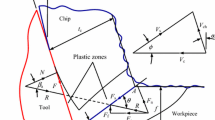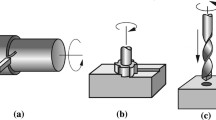Abstract
Investigations on metal-cutting machining processes that were conducted since the second half of the twentieth century have considerably contributed to disclosing the principles underlying the cutting process. Although numerous studies have been carried out on this subject, a generally valid model of the cutting process and the interactions in the separating processes does not exist yet. Such a model could guarantee the disclosure of the principles of thermodynamic interactions between the cutting process and the involved machine structure. This contribution is twofold and presents an experimental setup used to determine cutting forces and temperatures in orthogonal cutting processes. The results are then used as a reference for simulations made with the Discrete Element Method (DEM). The DEM is due to its meshless nature well suited to capture large deformations and rupture of material which is included very naturally. It is examined to which extent the measured results can be captured with the DEM model.


















Similar content being viewed by others
References
Davies MA, Ueda T, M’Saoubi R, Mullany B, Cooke AL (2007) On the measurement of temperature in material removal processes. Annals CIRP 56(2):581–604
Körtvelyessy LV (1981) Thermoelement praxis (in German). Vulkan Verlag, Essen
Müller B (2004) Thermische analyse des Zerspanens metallischer Werkstoffe bei hohen Schnittgeschwindigkeiten (in German). Dissertation RWTH Aachen
Degner W, Lutze H, Smejkal E (1989) Spanende formung: theorie, berechnung, richtwerte (in German). Technik, Berlin
Jing L, Stephansson O (2007) Fundamentals of discrete element methods for rock engineering. Theory and applications. Elsevier, New York
Fleissner F (2010) Parallel object oriented simulation with Lagrangian particle methods, vol 16. Dissertation Schriften aus dem Institut für Technische und Numerische Mechanik der Universität Stuttgart, Shaker Verlag, Aachen
Geradin M, Rixen D (1998) Mechanical vibrations. Wiley, Chichester
Lankarani H, Nikravesh P (1990) A contact force model with hysteresis damping for impact analysis of multibody systems. J Mechan Des 112:369–376
Gaugele T, Fleissner F, Eberhard P (2008) Simulation of material tests using Meshfree Langrangian particle methods. In: Proceedings of the institution of mechanical engineers, Part K: Journal Multi-body Dyn 222(K4):327–338
DIN10002 (2001) Metallische Werkstoffe Zugversuch—Prüfverfahren bei Raumtemperatur (in German). DIN Deutsches Institut für Normung e.V., Berlin
DIN10045 (1991) Kerbschlagbiegeversuch nach Charpy (in German). DIN Deutsches Institut für Normung e.V., Berlin
Gaugele T, Eberhard P, Storchak M, Heisel U (2008) A discrete material model used in a co-simulated Charpy impact test and for heat transfer. In: Proceedings of the 1 international conference on process machine interactions, pp 361–369
Tychonoff A, Samarski S (1959) Differentialglei-chungen der mathematischen Physik (in German). Deutscher Verlag der Wissenschaften, Berlin
Zehnder AT, Potdar YK, Bhalla K (2002) Plasticity induced heating in the fracture and cutting of metals. Thermo Mechan Fatigue Fract 209–244
Acknowledgments
The presented results were gained in the project HE 1656/90-1/3 and EB 195/6-1, EB 195/8-2/3 “Development and experimental verification of a simulation tool for the prediction and influence of dynamic and thermal interaction processes in cutting” within the priority program SPP 1180 Prediction and influence of interactions of structures and processes (ProWeSP), which was funded by the German Research Foundation (DFG). This support is highly appreciated and the authors thank the DFG and all partners in this SPP.
Author information
Authors and Affiliations
Corresponding author
Rights and permissions
About this article
Cite this article
Heisel, U., Storchak, M., Eberhard, P. et al. Experimental studies for verification of thermal effects in cutting. Prod. Eng. Res. Devel. 5, 507–515 (2011). https://doi.org/10.1007/s11740-011-0312-3
Received:
Accepted:
Published:
Issue Date:
DOI: https://doi.org/10.1007/s11740-011-0312-3




